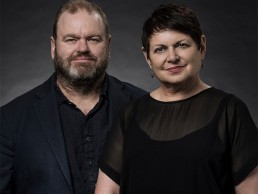
Ben Baxter & Ruth McDermott
Australian light artists Ben Baxter and Ruth McDermott have released a new book – Between Dark & Light, reflecting on their unique relationship of artistic collaboration and demonstrating some highlights from their 13-year career. Here, Baxter and McDermott sit down with arc to discuss the inspiration behind the book.
How did you meet and begin working together?
We met at the University of New South Wales in Sydney through the Industrial Design course. We started looking for opportunities to collaborate on urban renewal and pop-up installations in Sydney. When the chance came to participate in the first Vivid festival, we applied together.
Is there a philosophy behind your work?
Our work tends to come from our experiences living on the east coast of Australia. From this we tend to explore ideas around landscape, beach, water, rock, and the natural environment. We were inspired by British artists Gilbert and George, who use their everyday life as the basis for their practice. We often talk about artists that inspire us. Caravaggio for light and shadow, Matisse for colour, Dan Flavin for his absolute simplicity and ease, the scale and ambition of Christo and Jeanne-Claude. We are inspired by light itself but also darkness and treat each with equal importance. We like the romance and sensuality of light, particularly as it interacts with materials, be they shiny, glittery, textured or diffuse. The darkness adds richness and mystery. Place is a key feature of our work and often influences ideas or direction for future work while in situ at the site. Where we locate our work is paramount to a successful installation and we divided these hierarchies for all the projects in the book by their type of location – waterside, urban, landscape and interior. Each special typology has its own challenges and characteristics.
Why is light art so important for the urban environment?
Light art is the jewelled necklace to a little black dress. It creates a sense of surprise and embellishment to the experience of spaces, and adds a layer of discovery, even fantasy, to the public realm. Light can add an extra dimension and make people see the space differently. It adds to the activation of public space – it can make the experience of cities richer, more fun and safer.
What was the inspiration behind the new book?
We wanted to document the evolution of light art, light festivals, and the use of LED technology through our own personal experience. But more personally, we wanted to explore the dynamics of collaborative art practice. We felt that there was very little unpacking of how this process of artistic collaboration actually works. We structured the book to talk about how we were inspired to create each piece and the process of realising the final light artwork – an often complex and torturous process. We also add our individual viewpoints; we both have post-graduate degrees associated with lighting and one thing we found with our studies is there is surprisingly little written about lighting and very few books around the subject. We wanted to give a voice to the medium we love.
How did the opportunity come about?
Ruth did her PhD in lighting at UTS (University of Technology) in Sydney, and Ben studied Landscape Architecture there. We had both taught at the institution in Industrial Design. Ruth approached their publishing arm, UTS ePress, who publish peer reviewed books and journals and they were interested. They felt that the connection between technology and creativity that underpins light art suited the university’s aim. That was the beginning, however, it has been a four-year process – through pandemic and changes of staff. We feel fortunate that they have persisted with this.
What is your ambition for the book?
We wanted to share the journey we have had over the past 13 years – we were part of something incredible at the start of the LED revolution where the technology started to change the way we could use light in urban spaces. This innovation offered new opportunities for artistic practice. We hope people are inspired by our ways of developing work – we have tried to unpack our process as much as possible and also describe our collaboration. We have always brought something different to the table and this is explored in the book.
Where do you see light art going in the future?
A history of light art is discussed in one of the chapters of the book, exploring how the medium developed as an artistic practice from the early days of Baroque spectacle to work in the 21st century. It was fascinating to see how new lighting technologies have contributed to innovative artistic explorations. Currently, we are seeing a growth in the use of LED tubes that rely on the rapid changing of hue and saturation of light to create impressive effects. We wonder if this more kinetic art, not really celebrating the romance and emotional effect lighting can have, dazzles rather than engages the viewer. The challenge for artists using new lighting technologies is to create work that has a degree of beauty, wit or intrigue, evoking an emotional response and creating a connection with the viewer.
Between Dark and Light is available online at www.doi.org/10.5130/aak, with hard copies available at www.au.blurb.com/b/11251977-between-dark-and-light



